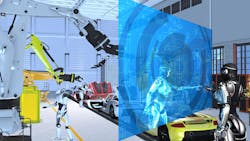The Fourth Industrial Revolution: Challenges for Enterprises and their Stakeholders
Of the all the burning issues discussed at the World Economic Forum in Davos, Switzerland, earlier this year, one that got top billing was the promise and peril of the “Fourth Industrial Revolution.” What does this Fourth Industrial Revolution mean for enterprises and their various stakeholders? What should they do to keep pace with it and create competitive advantage to come out ahead?
The Third Industrial Revolution—the digital age that began in the mid-20th century—was about computerization. The Fourth Industrial Revolution we are experiencing today builds on this first wave of computerization with the latest, rapidly evolving and disruptive advances in technology: the Internet of Things, the Industrial Internet, robotic process automation, autonomous vehicles, artificial intelligence, 3D printing, cyber-physical systems and connected wearable devices. As these sophisticated tools and technologies begin to converge, the impacts of the fourth Industrial Revolution are starting to become evident across many industries.
It is in this dizzying context that businesses and their stakeholders must find answers to some foundational questions:
1. What does the Fourth Industrial Revolution mean for research and development? Consumers of all types of products and services—from medicines to mobility—are demanding personalization, customization and local production.
A global coffee machine manufacturer, for example, has launched a web configurator that gathers real-time purchasing data to identify consumer preferences and understand the types of coffee for which they are willing to pay more. Armed with this data, the manufacturer then uses 3D printing to design a machine that offers a higher level of customization and dispenses coffee made specifically to match a certain market segment. These valuable insights fueled by big data will give customers an unprecedented level of influence in new product development and provide manufacturers new streams of more profitable revenue.
As they keep pace with the changing customer expectations, enterprises will need to integrate this new way of thinking into all aspects of their research and product development, whether it comes from in-house capabilities or external partners. Their goals will need to be centered on maintaining alignment with innovation initiatives and reducing time to market.
2. What does it mean for manufacturing? In the Fourth Industrial Revolution, enterprises will need to merge their virtual and real production domains as much as possible with the help of advanced software, automation and data integration. Production processes and automation should be designed and commissioned virtually in tight collaboration with suppliers and partners.
Manufacturers that want to retain their competitive advantage will increase production flexibility, automate logistics and deploy smart machines and smart products along the manufacturing value chain. A global industrial pump manufacturer, for example, that uses virtual tools and equipment to structure the location and flow of production lines will then be able to more carefully position automation lines, robots, production cells and people to reduce inventory and maximize productivity.
3. What does it mean for engineering? Engineers must streamline the way they design, develop and produce new products and services. In a complex and interconnected network of manufacturers and suppliers, the roles and touchpoints of designers, service providers and customers are constantly changing, and engineers need a cross-functional and collaborative approach that will help them monitor product and customer lifecycles. Gathering data at all stages will be a critical part of this process.
4. What does it mean for the CIO and the IT function? IT systems, especially production systems, are already at the heart of today’s enterprise. In the coming years, these systems will connect to more and more sub-systems, including service provider and customer networks. This is the new way of doing business—the convergence of information technology (IT) and operations technology (OT)—in which business processes and office automation will communicate and connect with industrial processes and factory automation. Interacting networks for physical and digital components will be co-engineered to create cyber-physical systems and provide the foundation of smart services.
CIOs and IT organizations must strike the right balance of in-house and sourced talent to serve this complex marketplace and avoid the effects of shadow IT or the risk of fading into a back-office function. One CIO at a European shipping port authority is doing just that. His organization has launched several initiatives to improve the efficiency of harbor operations, including a project that gathers data on ship movements and traffic patterns to ensure cargo containers reach the harbor at the right time to optimize processing and delivery.
5. What does it mean for employees and HR? In the short term, automation will displace some low-skilled workers who perform simple, repetitive tasks. However, employment overall will increase in the next decade, albeit with a requirement of different skills. The increasing market demand for software that leverages connectivity and analytics means employees with competencies in IT and software development will be highly sought after. Some manufacturers are beginning to recruit “Industrial Data Scientists” to conduct advanced data analytics, program robots and improve processes. Mastering this skill transformation will be an important survival tactic.
Revolutions are, by definition, dynamic, disruptive and destructive. The Fourth Industrial Revolution presents near-unlimited opportunity for those enterprises that are able to adapt quickly and embrace change. Lethargic companies that treat this as a peripheral phenomenon may not survive at all.
Long live the revolution! Until the next one comes along.
